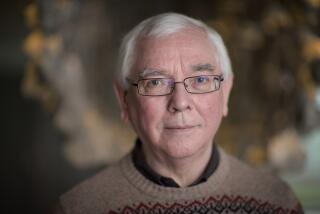Merton E. Davies; Led Effort to Create Satellite Imaging Technology
- Share via
Merton E. Davies, a longtime scientist with the Rand Corp. who was a leading figure in the creation of the first space reconnaissance satellites, has died. He was 83.
Davies, an engineer, reconnaissance system designer, imagery interpreter and space cartographer, died April 17 at his home in Santa Monica after surgical complications.
Honored last year by the National Reconnaissance Office as one of the 10 scientists who made significant contributions to the field, Davies retired from Rand in 1998.
Born in St. Paul, Minn., Davies grew up in Palo Alto. He earned a degree in mathematics from Stanford and continued graduate studies there before taking a job as a mathematics instructor at the University of Nevada in Reno.
But Davies soon left academia for the burgeoning aerospace industry in Southern California, joining Douglas Aircraft in 1940. He eventually transferred to what was then called the Rand project, based in Santa Monica. Davies stayed with Rand when it separated from Douglas in 1948, working on satellite vehicle designs, camera designs and image interpretation.
Davies’ major work started in 1954, when he teamed up with Amron Katz to investigate the use of advanced camera and imaging process systems for balloon, aircraft and satellite reconnaissance systems.
In 1957, the two recommended accelerated development of film-recoverable reconnaissance satellites with longer focal length lenses for improved ground resolution of imagery. Davies conceived and patented a spin-stabilized panoramic camera for Earth imaging.
These recommendations, offered in secret briefings to the Air Force, suggested satellite technology would enhance the ability to gather intelligence.
The Air Force readily accepted the recommendation.
This led to the establishment of the Corona satellite project, which was in operation from 1960 to 1972, filming more than 800,000 images.
In the late 1950s, Davies served as an expert on the U.S. delegation to the Surprise Attack Conference in Geneva and wrote a section of the final report on detection capability from aircraft and satellites.
He also worked at the Pentagon, analyzing Soviet weapons systems from the photographic evidence compiled by the Corona project and U-2 spy planes.
From the late 1960s through the 1990s, Davies participated in NASA’s planetary exploration program. He adapted photographic techniques to support planetary mapping. He served on the Imaging Science Teams of the Mariner 6, 7 and 9 missions to Mars and the Mariner 10 mission to Venus and Mercury.
A member of the American Institute of Astronautics and Aeronautics, American Society of Photogrammetry and a fellow of the American Geophysical Union, Davies also co-wrote “The View From Space,” “Atlas of Mercury” and “Rand’s Role in the Evolution of Balloon and Satellite Observation Systems and Related U.S. Space Technology.”
He is survived by his wife, Louise of Pacific Palisades; two sons, Randell and Albert; a daughter, Deidra; nine grandchildren and one great-grandchild; and a sister, Joyce Dresia.
Funeral services are scheduled for 2 p.m. today at Valley Oaks Memorial Park, 5600 Lindero Canyon Road, Westlake Village.





